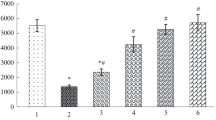Abstract
A study of the effect of a seasonal decrease in ambient temperature on the composition of free amino acids and ninhydrin-positive secondary metabolites in gastrocnemius muscles of the frog Rana temporaria revealed that at the onset of winter anabiosis, as compared to the summer season, the alanine pool increased from 2.43 to 6.10 µmol/g w.w., and the 3-methylhistidine pool rose from 1.52 to 2.80 µmol/g w.w. For the first time, muscles of poikilothermic animals (namely, frogs) were found to contain cysteic acid and phosphoethanolamine, the level of which increased by the onset of hibernation, particularly for cysteic acid (from 0.91 to 2.15 µmol/g w.w.). The taurine level proved to be far lower compared to animals both of lower and higher phylogenetic ranks, but by the onset of hibernation it increased almost threefold. Presumably, the accumulation of the above metabolites relates to their protective role at temperatures that are extremely low for the survival of R. temporaria.

Similar content being viewed by others
REFERENCES
Hochachka, P.W. and Somero, G.N., Biochemical Adaptation: Mechanism and Process in Physiological Evolution, New York: Oxford University Press, 2002.
Storey, K.B. and Storey, J.M., Freeze tolerant frogs: cryoprotectants and tissue metabolism during freeze-thaw cycles, Can. J. Zool., 1986, vol. 64(1), pp. 49–56.
Karanova, M., Influence of low temperature on the evolution of amino acids pools adaptive modifications in poikilothermic animals (review), Int. J. Biochem. Biophys., 2013, vol. 1(2), pp. 33–40.
Sømme, L., The effect of temperature and anoxia on haemolymph composition and supercooling in three overwintering insects, J. Insect Physiol., 1967, vol. 13, pp. 805–814.
Karanova, M.V., Impact of seasonal temperature decrease and cold shock on the composition of free amino acids and phosphomonoethers in various organs of Amur sleeper Perccottus glenii (Eleotridae), J. Ichthyol., 2018, vol. 58(4), pp. 570–579.
Karanova, M.V., Secondary metabolites and aspartic acid in the brain of the frog Rana temporaria as low-temperature adaptogens, J. Evol. Biochem. Physiol., 2020, vol. 56(3), pp. 207–212.
Churchill, T.A. and Storey, K.B., Organ metabolism and sryoprotectant synthesis during freezing in spring peepers Pseudacris crucifer, Copeia, 1996, (3), pp. 517–525.
Churchill, T.A. and Storey, K.B., Natural freezing survival by painted turtles Chrysernys picta rnarginata and C. picta bellii, Amer. J. Physiol., 1992, vol. 11, pp. R530–R537.
Churchill, T.A. and Storey, K.B., Freezing survival of the garter snake Thamnophis sirtalis, Can. J. Zool., 2011, vol. 70(1), pp. 99–105.
Spachman, D.H., Stein, W.H., and Moore, S., Automatic recording apparatus for use in the chromatography of amino acids, Anal. Chem., 1958, vol. 30(7), pp. 1190–1206.
Schmalhausen, I.I., Osnovy sravnitel’noi anatomii pozvonochnykh zhivotnykh (Foundations of Comparative Anatomy of Vertebrate Animals), Moscow, 1947.
Karanova, M.V., Free amino acid composition in blood and muscle of the gobi Perccottus glenii at the period of preparation and completion of hibernation, J. Evol. Biochem. Physiol., 2009, vol. 45(1), pp. 67–77.
Nakagawa, H., Lindsay, R.H., and Cohen, P.P., Composition and labeling patterns of “free” and protein amino acids in Rana catesbeiana tadpoles and frogs, Arch. Biochem. Biophys., 1964, vol. 106, pp. 299–306.
Asatoor, A.M. and Armstrong, M.D., 3-Methylhistidine, a component of actin, Biochem. Biophys. Res. Com., 1967, vol. 26(2), pp. 168–174.
Muradyan, A.Sh., Edigaryan, A.N., and Galoyan, A.A., The content of amino acids and other ninhydrin-positive compounds in the cattle heart muscle, Biol. Zh. Armen., 1981, XXXIV(9), pp. 968–972.
Garaeva, O.I., Sulfur-containing amino acids as markers of the state of stress, Fiziol. şi Sanocreatol. Bul. AŞM. Ştiinţele vieţii, 2011, vol. 3(315), pp. 50–62. 2011.
Grimble, F.R., The effects of sulfur amino acid intake on immune function in humans, J. Nutr., 2006, vol. 136(6), pp.1660–1665.
Sheibak, V.M., Lyakh, I.V., Doroshenko, E.M., Smirnov, V.Yu., and Mogilevets, O.N., Free amino acids and their nitrogen-containing metabolites in the rat hypothalamus in acute dinil intoxication and their correlation with plasma amino acid spectrum, Vestnik VGMU, 2012, vol. 11(1), pp. 31–35.
Harris, R. and Wen, S., Review: Taurine: a “very essential” amino acid, Mol. Vis., 2012, vol. 18, pp. 2673–2686.
Ito, T., Kimura, Y., Uozumi, Y., Takai, M., Muraoka, S., Matsuda, T., Ueki, K., Yoshiyama, M., Ikawa, M., Okabe, M., Schaffer, S.W., Fujio, Y., and Azuma, J., Taurine depletion caused by knocking out the taurine transporter gene leads to cardiomyopathy with cardiac atrophy, J. Mol. Cell. Cardiol., 2008, vol. 44, pp. 927–937.
Iwata, K., Nitrogen metabolism in the mudskipper, Periophthalmus cantonens: changes in free amino acids and related compounds in various tissues under conditions of ammonia loading, with special reference to its high ammonia tolerance, Comp. Biochem. Physiol. Pt. A, Physiol., 1988, vol. 91(3), pp. 499–508.
Galloway, S.D., Talanian, J.L., Shoveller, A.K., Heigenhauser, G.J., and Spriet, L.L., Seven days of oral taurine supplementation does not increase muscle taurine content or alter substrate metabolism during prolonged exercise in humans, J. Appl. Physiol., 2008, vol. 105(2), pp. 643–651.
Tachiki, K.H. and Baxter, C.F., Taurine: levels in brain tissue: the need for reevaluation, J. Neurochem., 1979, vol. 33(5), pp. 1125–1129.
Morozov, V.I., Sakuta, G.A., and Kalinski, M.I., Sphingosine-1-phosphate: distribution, metabolism and role in the regulation of cellular functions, Ukr. Biochem. J., 2013, vol. 85(1), pp. 5–21.
Ferreira, A.K., Meneguelo, R., Pereira, A., et al., Anticancer effects of synthetic phosphoethanolamine on Ehrlich ascites: an experimental study, Anticancer Res., 2012, vol. 32(1), pp. 95–104.
Author information
Authors and Affiliations
Corresponding author
Additional information
Russian Text © The Author(s), 2021, published in Zhurnal Evolyutsionnoi Biokhimii i Fiziologii, 2021, Vol. 57, No. 2, pp. 165–171https://doi.org/10.31857/S0044452921010058.
Translated by A. Polyanovsky
Rights and permissions
About this article
Cite this article
Karanova, M.V. Low-Temperature Adaptation of the Rana temporaria Gastrocnemius Muscle at the Onset of Anabiosis. J Evol Biochem Phys 57, 252–259 (2021). https://doi.org/10.1134/S0022093021020071
Received:
Revised:
Accepted:
Published:
Issue Date:
DOI: https://doi.org/10.1134/S0022093021020071



